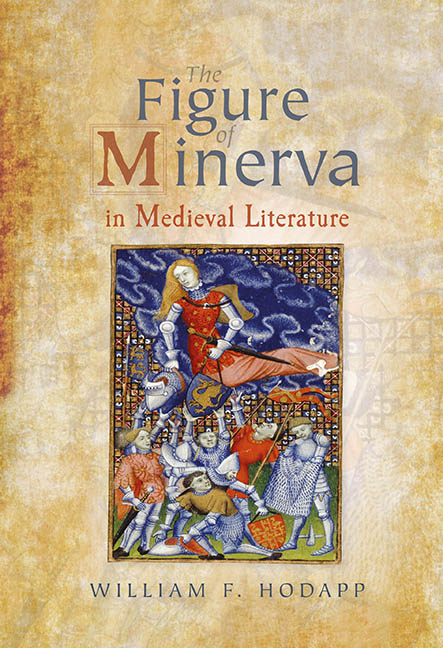Book contents
- Frontmatter
- Dedication
- Contents
- Illustrations
- Acknowledgements
- Abbreviations
- Introduction
- 1 The Roman Minerva and Elements of Medieval Classicism
- 2 The Sapiential Tradition: Minerva as Redemptress
- 3 The Martianus Tradition: Minerva as Mistress of the Liberal Arts
- 4 The Patrona Tradition: Minerva as Protectress and Benefactor
- 5 The Patristic Tradition: Minerva as Idol
- 6 The Ovidian Tradition: Minerva as Venus’ Ally
- Conclusion
- Bibliography
- Index
- Frontmatter
- Dedication
- Contents
- Illustrations
- Acknowledgements
- Abbreviations
- Introduction
- 1 The Roman Minerva and Elements of Medieval Classicism
- 2 The Sapiential Tradition: Minerva as Redemptress
- 3 The Martianus Tradition: Minerva as Mistress of the Liberal Arts
- 4 The Patrona Tradition: Minerva as Protectress and Benefactor
- 5 The Patristic Tradition: Minerva as Idol
- 6 The Ovidian Tradition: Minerva as Venus’ Ally
- Conclusion
- Bibliography
- Index
Summary
Drawing this study to a close, I would like to return briefly to “Vpon temse,” the short dream vision in Leiden, University Library Vossius Germ. Gall. Q.9, folio 112r, with which I began this book:
Vpon temse fro London myles iij
jn my chambir riht as j lay slepyng
me thought I sawe apperyng vn to me
the fresh venus mercifully lokyng
vpon her fyngris many a strange Ring
of which the stonys gaf so gret clernesse
that neuer sawe j so fresh a brithnesse
And in her hand me semed that she helde
depeynted vpon a skyn of velem whiht
the Resemblance of a floury felde
and in the meddis a woman stod vp right
of which the figure so fayre was to my siht
that neuer in gravyng nor in portrature
sawe j depict so fayre A creature
The word “venus,” as I argued in the Introduction, is crucial to understanding the poem's subject: the narrator assumes his narratee understands fully the reference; without it, the narratee (and we ourselves) would not necessarily know the poem is about love. This particular reference illustrates poetics and reading practices at the heart of medieval classicism. In naming the dream's central figure “venus,” the poet invites the poem's audience to read intertextually, which as Jo-Marie Claassen describes the practice is “a form of ‘literary anamnesis’”: a recollective interpretive exercise relying on previous reading experiences.
As with any first-person dream-vision narrative, readers base resulting interpretations of “Vpon temse” on an assumption about the narrator recollecting the dream event; that is, we assume the narrator is correct when naming the poem's female vision figure. This assumption leads to yet another fundamental question in this case: how did the dreamer-narrator know that this vision figure in the first stanza, whom he describes in the second stanza as holding a painting, was indeed Venus? This appearance of a female vision figure in “Vpon temse” joins, as we have seen, a long line of such appearances stretching back to biblical and classical texts. When considering visionary literature, though, we also note a trend in which narrators describe vision figures in some detail as well as, and often prior to, identifying the figure.
- Type
- Chapter
- Information
- The Figure of Minerva in Medieval Literature , pp. 247 - 256Publisher: Boydell & BrewerPrint publication year: 2019



